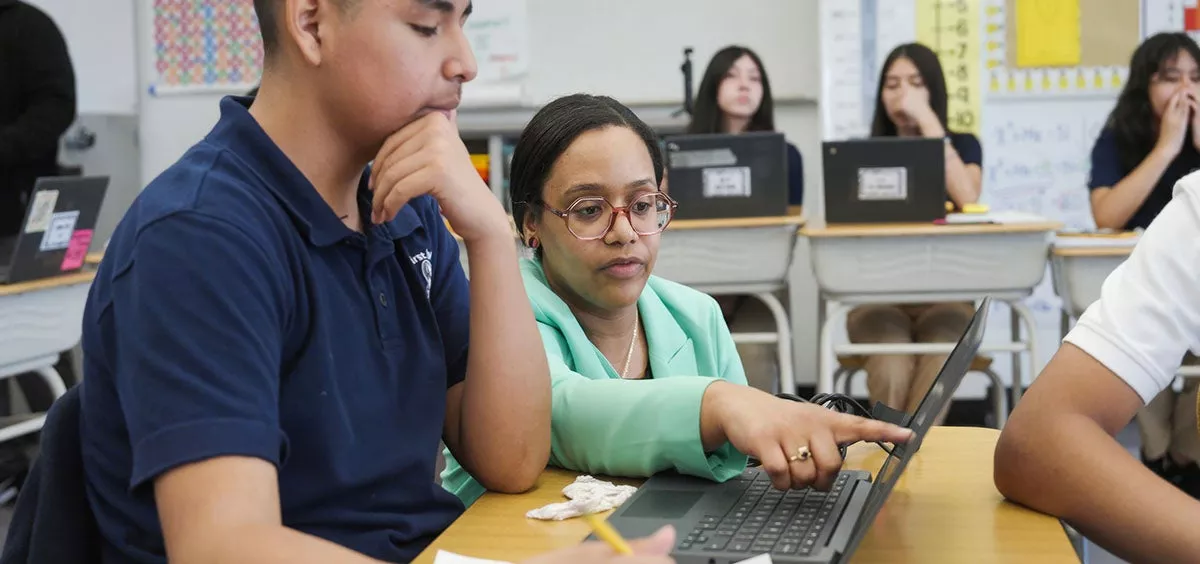My trip to the frontier of AI education
By support | August 11, 2024 | minute read

When I was a kid, my parents took me to the World’s Fair in Seattle. It was amazing to see all these fantastic technologies that felt like something out of a science fiction novel. I asked them to take me back multiple times during the six months it was open here, and I remember walking away from the fairgrounds each time feeling that I had just caught a glimpse of the future.
That feeling came back to me recently as I walked out of a classroom in Newark, New Jersey.
In May, I had the chance to visit the First Avenue Elementary School, where they’re pioneering the use of AI education in the classroom. The Newark School District is piloting Khanmigo, an AI-powered tutor and teacher support tool, and I couldn’t wait to see it for myself.
I’ve written a lot about Khanmigo on this blog. It was developed by Khan Academy, a terrific partner of the Gates Foundation. And I think Sal Khan, the founder of Khan Academy, is a visionary when it comes to harnessing the power of technology to help kids learn. (You can read my review of his new book, Brave New Words, here.)
We’re still in the early days of using AI in classrooms, but what I saw in Newark showed me the incredible potential of the technology.
I was blown away by how creatively the teachers were using the tools. Leticia Colon, an eighth-grade algebra teacher, explained how she used AI to create problem sets about hometown heroes the students might be interested in. In February, Khanmigo helped her develop equations that incorporated Newark boxer Shakur Stevenson’s workout routines, so her students could practice math skills while learning about a real-world role model.
Cheryl Drakeford, a third-grade math and science teacher, talked about how she uses Khanmigo to help create rubrics and lesson hooks for assignments. The technology gives her a first draft, which she then tailors for her students. For example, the AI once gave her a hook that used a generic story about a fruit stand, and she edited it to be about Pokémon cards and Roblox—two topics her students are passionate about. “Khanmigo gives me the blueprint, but I have to give the delivery,” she said.
Several of the teachers I met with showed me how they can access each student’s dashboard and get a summary of how they’re doing in a particular subject. They loved being able to easily and quickly track a student’s progress, because it’s saving them a lot of time. They were also excited about how their students are using Khanmigo as a personalized tutor.
This technology is far from perfect at this point. Although the students I met loved using Khanmigo overall, they also mentioned that it struggled to pronounce Hispanic names and complained that its only voice option is male—which makes it clear how much thought must still be put into making the technology inclusive and engaging for all students. In an ideal world, the AI would know what the students in Ms. Drakeford’s class are into, so she wouldn’t have to do any editing. And Ms. Colon told me it took her several tries to get Khanmigo to give her what she wanted.
In other words, my visit to Newark showed me where we are starting from with AI in the classroom, not where the technology will end up eventually. It reinforced my belief that AI will be a total game-changer for both teachers and students once the technology matures. Even today, when the teachers at First Avenue delegate routine tasks to AI assistants, they reclaim time for what matters most: connecting with students, sparking curiosity, and making sure every child feels seen and supported—especially those who need a little extra help.
Khanmigo is just one of many AI-powered education tools in the pipeline, and the Gates Foundation is focused on ensuring these tools reach and support all students, not just a few. Our goal is that they help level the playing field, not widen existing gaps. We’re currently working with educators across the country to get feedback and make the technology more responsive to their needs. Visits like the one I took to Newark are part of that process. It was fantastic to learn what teachers were enthused about and see how different students are engaging with AI.
The educators I met in Newark are true pioneers. Some were on the cutting edge, constantly looking for new ways to use AI in their classroom. Others were using it in a more limited fashion. I was impressed by how the school was able to support each teacher’s comfort level with the technology. They’re putting a lot of thought into change management and making sure that no educator is forced to try things that won’t work in their classroom.
That’s because, at the end of the day, teachers know best. If you hand them the right tools, they will always find a way to support their students. My visit to Newark left me more optimistic than ever that AI will help teachers do what they do best and free them up to focus on what matters most.